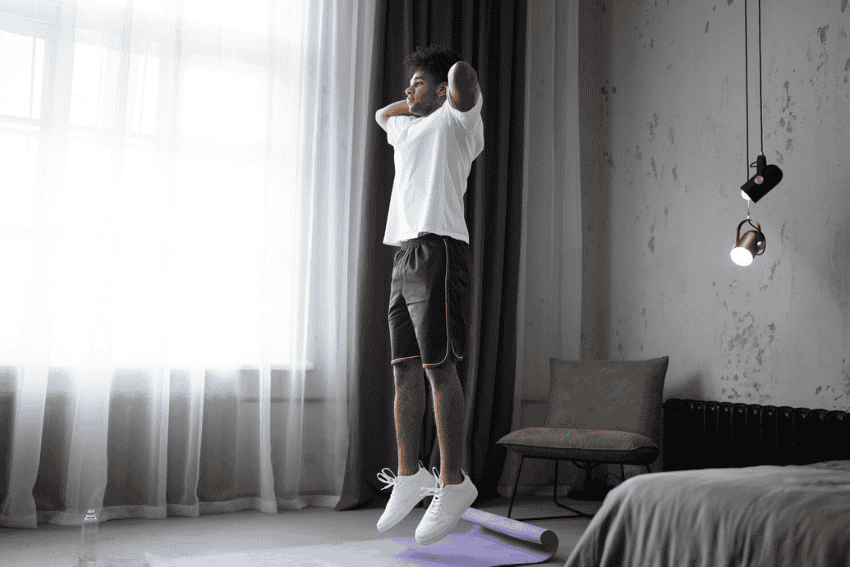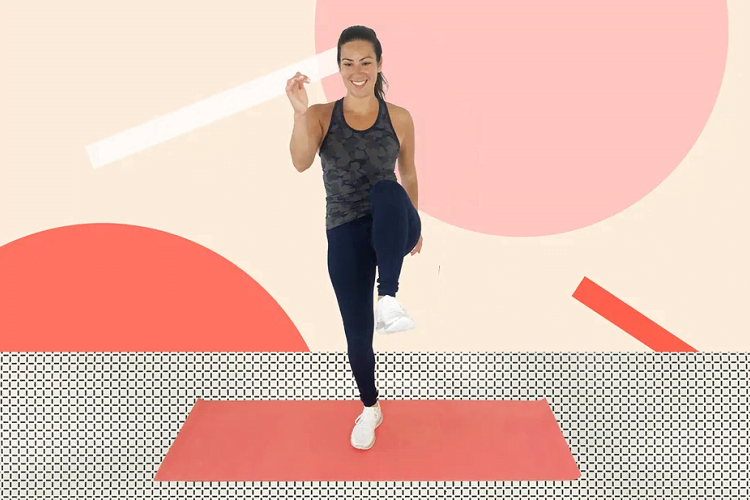Cardio exercises are cornerstone of physical health, offering benefits like improved heart function, increased stamina, and enhanced mood. The best part? You don’t need a gym or fancy equipment to get a great cardio workout.
With just a small space in your living room or bedroom, you can perform effective exercises that elevate your heart rate and boost overall fitness. From high-energy moves to low-impact options, home cardio exercises are accessible, cost-effective, and adaptable to any fitness level, making them ideal for beginners and seasoned athletes alike.
Creating a home cardio routine allows you to exercise on your own schedule, eliminating barriers like travel time or gym memberships. Whether you’re aiming to burn calories, reduce stress, or build endurance, the right combination of exercises can help you achieve your goals.
This article explores the best cardio exercises you can do at home, along with tips to maximize safety and effectiveness, ensuring you get a heart-pumping workout without stepping outside your door.
Benefits of Cardio Exercises at Home
Cardio exercises at home offer a convenient and effective way to enhance your overall health. Here are some key benefits:
- Improves Heart Health: Regular cardio, like jumping jacks or running in place, strengthens the heart, improves circulation, and lowers blood pressure, reducing the risk of cardiovascular diseases.
- Boosts Mood and Energy: Cardio releases endorphins, helping to reduce stress, anxiety, and depression while increasing energy levels for daily tasks.
- Enhances Stamina: Consistent home workouts, such as dance routines or high knees, build endurance, making physical activities easier over time.
- Supports Weight Management: Cardio burns calories, aiding in weight loss or maintenance when paired with a balanced diet.
- Saves Time and Money: No gym membership or commute is needed—just a small space and minimal equipment, making it accessible and cost-effective.
With these benefits, home cardio workouts are a versatile and impactful addition to any fitness routine.
Top Cardio Exercises to Try at Home
Here, we’ll cover some of the best cardio exercises that you can perform without any equipment. Each one is designed to elevate your heart rate, engage multiple muscle groups, and provide a full-body burn. I’ll describe how to do them, their benefits, and some tips for success. Aim to do each for 30-60 seconds per set, with rests in between, and repeat circuits as needed.
Jumping Jacks

Jumping jacks are a classic cardio exercise that’s simple yet effective for getting your blood flowing. They work your legs, arms, and core while improving coordination. I remember doing these as a kid in gym class, and they still pack a punch today.
To perform jumping jacks:
- Stand with your feet together and arms at your sides.
- Jump your feet out wide while raising your arms overhead.
- Jump back to the starting position.
- Repeat at a steady pace.
Benefits: Enhanced cardiovascular endurance and calorie burn. They’re great for warming up or as part of a HIIT routine.
Tip: Keep your knees soft to avoid joint strain, and if you’re a beginner, step side to side instead of jumping. Variations like star jumps add intensity by spreading your limbs wider.
High Knees

High knees mimic running but amp up the intensity by lifting your knees higher. This exercise targets your lower body and core, making it excellent for building speed and agility.
Here’s how to do it:
- Stand tall with feet hip-width apart.
- Run in place, driving your knees up toward your chest alternately.
- Pump your arms for momentum.
- Maintain a quick pace.
Benefits: Range from improved hip flexibility to stronger quads and calves. It’s a fantastic fat-burner too.
Tip: Focus on form to prevent slouching, and slow down if needed for beginners. Advance by adding a twist or holding for a second at the top.
Burpees
Burpees are a full-body powerhouse that combines squats, push-ups, and jumps. They’re intense but rewarding, often called the king of cardio exercises for their efficiency.
Steps:
- Start standing, then squat down and place hands on the floor.
- Jump feet back to a plank position.
- Do a push-up, then jump feet forward.
- Explode up into a jump with arms overhead.
- Land softly and repeat.
Benefits: They build strength, endurance, and burn tons of calories. Ideal for HIIT.
Tip: Modify by skipping the push-up or jump if it’s too challenging. Over time, you’ll notice better overall fitness.
Mountain Climbers
Mountain climbers simulate climbing and engage your core, shoulders, and legs. They’re low-impact but high-intensity, perfect for home workouts.
How to:
- Get into a plank position.
- Drive one knee toward your chest, then switch quickly.
- Keep alternating at a fast pace.
- Maintain a straight back.
Benefits: Include core strengthening and heart rate elevation without jumping. Great for abs.
Tip: Avoid sagging hips; if wrists hurt, use fists. Variation: Slow it down for more control or add a twist for obliques.
Squat Jumps
Squat jumps add explosiveness to regular squats, targeting your glutes, quads, and calves for a serious cardio boost.
Perform them like this:
- Stand with feet shoulder-width apart.
- Lower into a squat.
- Jump up explosively, reaching arms up.
- Land softly and repeat.
Benefits: They improve power and burn fat quickly. Excellent for athletes.
Tip: Land with bent knees to absorb impact. Beginners can do regular squats first. Advance with tuck jumps for more challenge.
Lunge Jumps
Lunge jumps alternate legs, working your lower body while keeping your heart rate up. They’re dynamic and fun.
Steps:
- Start in a lunge position, one foot forward.
- Jump up and switch legs in mid-air.
- Land in the opposite lunge.
- Continue alternating.
Benefits: Better balance, stronger legs, and calorie torching.
Tip: Keep your front knee over the ankle. Modify by stepping instead of jumping. This one’s great for variety in routines.
Skater Jumps
Inspired by speed skating, skater jumps improve lateral movement and agility.
How to do:
- Stand on one foot, then jump sideways to the other.
- Swing arms for balance.
- Touch the ground lightly if needed.
- Alternate sides.
Benefits:They enhance coordination and target outer thighs. Super for sports prep.
Tip: Start slow to master form. Variation: Add a hop for intensity.
Running in Place
Simple yet effective, running in place is like jogging without moving forward. It’s customizable and easy on space.
To execute:
- Stand and start jogging, lifting knees moderately.
- Swing arms naturally.
- Increase speed for more intensity.
Benefits: Builds endurance, easy to start.
Tip: Add high knees or butt kicks for variation. Perfect for small apartments.
Shadow Boxing
Shadow boxing involves punching the air, engaging your upper body and core for a fun cardio session.
Steps:
- Stand in a boxing stance.
- Throw jabs, crosses, hooks, and uppercuts.
- Move feet lightly.
- Keep going for timed rounds.
Benefits: It improves speed, coordination, and relieves stress.
Tip: Imagine an opponent for motivation. Beginners can slow punches.
Plank Jacks
Plank jacks combine planks with jumping jacks for core-focused cardio.
How:
- Start in plank.
- Jump feet out wide, then back together.
- Keep core tight.
Benefits: Strengthens abs, boosts heart rate.
Tip: Step feet if jumping’s hard. Great finisher.
Bicycle Crunches
While more core-oriented, bicycle crunches add a cardio element with speed.
Steps:
- Lie on back, hands behind head.
- Pedal legs while twisting torso to meet opposite elbow to knee.
- Alternate quickly.
Benefits: They target obliques and burn calories.
Tip: Don’t pull neck. Slow for form.
Dancing
Dancing to music is an enjoyable way to do cardio exercises without feeling like work.
To get started:
- Pick upbeat songs.
- Move freely: jump, twist, shimmy.
- Aim for continuous motion.
Benefits: Fun, improving mood, customizable.
Tip: Follow online videos for structure. It’s sustainable long-term.
These exercises provide a solid foundation for home cardio. Mix them up to keep things fresh and target different muscles.
How to Create a Home Cardio Routine
Building a home cardio routine is an effective way to improve cardiovascular health without needing a gym. Follow these steps to design a safe and engaging workout plan:
- Set Clear Goals: Decide if you want to boost endurance, burn calories, or improve heart health. Aim for 20–30 minutes per session, 3–5 times a week.
- Choose Varied Exercises: Mix high-energy moves like jumping jacks, high knees, or burpees with lower-intensity options like marching in place or step-ups to keep it fun and balanced.
- Structure Your Workout: Start with a 5-minute warm-up (e.g., dynamic stretches), followed by 15–20 minutes of cardio (alternate 1-minute intense bursts with 1-minute slower recovery), and end with a 5-minute cool-down.
- Use Household Items: No equipment? Use stairs for step-ups or a sturdy chair for modified mountain climbers. Add music to stay motivated.
- Track Progress: Monitor your heart rate or perceived effort to ensure you’re working at a moderate-to-vigorous pace. Adjust intensity as you improve.
Consistency is key—schedule sessions at a time that suits you and gradually increase duration or intensity to stay challenged.
Safety Tips for Cardio Exercises at Home
Cardio exercises at home, like jumping jacks, running in place, or dance workouts, are great for boosting heart health and stamina. However, to stay safe and avoid injury, follow these key tips:
- Warm Up Properly: Start with 5–10 minutes of dynamic stretches or light movements to prepare your muscles and joints. This reduces the risk of strains or sprains.
- Choose a Safe Space: Ensure your workout area is clear of obstacles, with a non-slip surface to prevent falls. Use proper footwear to support your feet and ankles.
- Listen to Your Body: Avoid overexertion by pacing yourself. If you feel dizzy, short of breath, or experience pain, stop immediately and rest.
- Stay Hydrated: Drink water before, during, and after your workout to maintain energy and prevent dehydration.
- Use Proper Form: Follow correct techniques to avoid stress on joints or muscles. If unsure, consider online tutorials or consult a fitness professional.
By prioritizing safety, you can enjoy effective cardio workouts at home while minimizing risks.
Conclusion
Incorporating the best cardio exercises at home into your life can lead to remarkable health improvements. From jumping jacks to dancing, these options are versatile, effective, and fun. Remember, the key is starting where you are and progressing steadily. With the routines and tips shared, you’re equipped to boost your fitness from home. Stay consistent, enjoy the process, and watch your energy soar. Here’s to a healthier you!
FAQs
Since many people have questions about starting cardio exercises at home, here are some common ones answered.
How often should I do cardio exercises at home?
Aim for 150 minutes of moderate cardio per week, spread over 3-5 days. Beginners start with shorter sessions.
Can I lose weight with just home cardio?
Yes, combined with a calorie deficit diet, it helps burn fat. Consistency is key.
What if I have no space for these exercises?
Focus on stationary ones like high knees or shadow boxing. Even small areas work.
Are these suitable for beginners?
Absolutely, with modifications. Start slow and build up.
How do I know if I’m doing enough intensity?
If you can talk but not sing, it’s moderate. For vigorous, conversation is hard.


